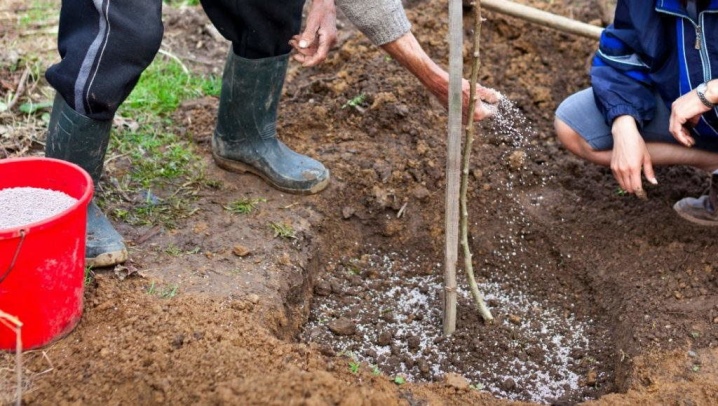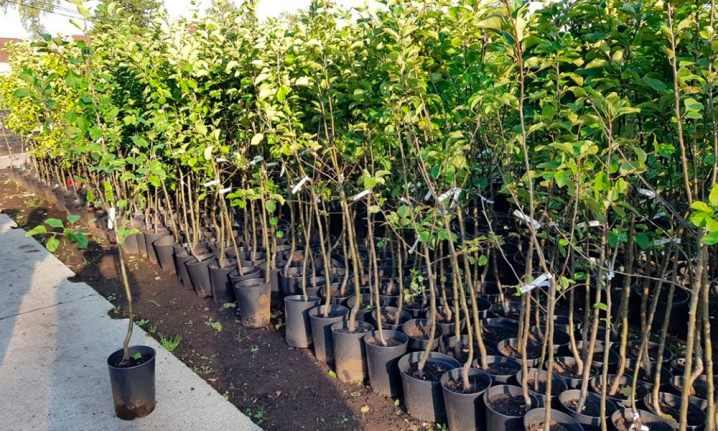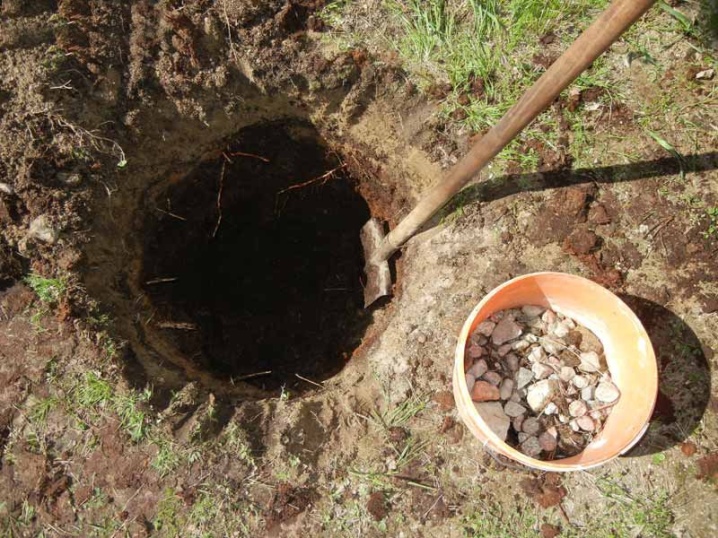Rules and scheme for planting apple trees in spring

On the old family plot, fruit trees are rarely planted - most likely, they already exist. But if the site is new or on the old one had to say goodbye to some trees, then the owners face the task of planting them. The most desirable in this case are, of course, apple trees. How to plant them in the spring, why it should be done at a particular period, what conditions, terms and technologies to take into account - all this will have to be learned by the owners of the site before solving a seemingly simple task of planting apple trees.

Advantages and disadvantages
Probably the most important plus of spring planting is the time left for the development of a young seedling in comfortable conditions. Frost is still very far away, and it is they that are dangerous for immature trees. In autumn, the risk of falling into the clutches of frost for a very young tree is much higher. During the spring, summer and autumn, the apple tree manages to take root well, get stronger, grow roots that will absorb all the essentials from the soil.
The tree, one might say, will settle in the chosen place, accumulate a sufficient supply of nutrients for the winter.

This means that for regions where winters are cold (and not only in Siberia), spring planting is more relevant. Where the soil is not the most fertile, the choice in favor of spring is also obvious. In addition, in the spring it is advantageous to plant those apple varieties that do not show any particular frost resistance. Finally, trees that are 1-2 years old will also better tolerate spring planting.

You should also know the disadvantages of planting a tree in spring.
- You need to have time to plant seedlings before bud break.
- If there is little moisture in the soil during a summer drought, the growth of new roots will slow down, and the development of the tree as a whole will slow down, it will become susceptible to various diseases, and risk dying.
- The irrigation schedule for the seedlings must be perfect - the price of a mistake is very high.
- If the spring temperature rises sharply, the sun literally beats down, then the young tree may get burned. Barely blossoming leaves and shoots will be exposed to the sun's rays.
- Quality seedlings, according to experienced gardeners, are more difficult to buy in the spring.

It would seem a decent list of cons, but one big plus - the supply of warm months - can cover them. And for some regions there is no choice at all - only spring and nothing else. In addition, it is quite within the power of the gardener to get rid of the minuses. He can choose the optimal planting time, organize watering, decide on a place, prepare seedlings in the fall.

Timing
The territory of Russia is huge, and climatically so heterogeneous that a universal answer cannot be dispensed with.
The farther north the area of residence, the colder the winters there (and longer), so the autumn landing may be initially a failure.
Regions and landing dates:
- North-West Region (including the Leningrad Region) - from the end of April to 10 May;
- south of Russia - all of April;
- Siberia - the first half of May;
- Ural - the first half of May;
- Moscow region - the second decade of April.

The exact timing is determined by the air temperature: as soon as it reaches a persistent 12-15 degrees Celsius during the day, you can get down to business. It is important that the soil also thaws so that it is not difficult to dig a hole (you will have to dig approximately 80 centimeters).
A seedling that has already bloomed cannot be planted, since such a specimen almost never takes root. Of course, the lunar calendar is also worth mentioning. Many gardeners check with him. In the calendar you can always find information on landings for the current period.

Selection and preparation of a seedling
The purchase of a seedling in the fall is not uncommon, and quite justified. And in order to preserve the material until spring, the trees can be sent to the basement, put in boxes and sprinkled with soil on the roots.
You can dig trees in the garden, maintaining an angle of 45 degrees, and then cover with a layer of earth and dry foliage.

Below are the criteria for choosing seedlings when buying them.
- You should focus on the level of groundwater in the territory. If the groundwater is higher than 2.5 m, then medium or low-growing varieties of apple trees are preferable. If the trees are tall, the roots will go deep into the ground, and they cannot stand stagnant water.
- The selection of seedlings is preferable in a local nursery, where the apple trees are adapted to the area and grafted.
- The trunk of the seedling should be smooth, free of scratches and build-ups.
- Biennial plants will be the best choice for planting. In a two-year-old, 2 or 3 lateral shoots extend from the main trunk.
- The roots of the plant should be elastic, and their length should be about 40 cm. The root can be pulled slightly, while it will begin to stretch.
- If you scratch the bark a little with your fingernail, it will turn green.
- Saplings with an open root system should not have open leaves.

If the trees are to be transported, they need to be protected: wrap open roots with a soft damp cloth, cover with foil, and gently pull the branches to the trunk with tape or rope. It is also worth remembering that the main sign of a healthy seedling is a developed root system. A large root and a small ground part are much better than the inverse proportion.

Site and soil requirements
Apple trees are considered sun-loving plants, and they also like to grow in higher elevations. For them, it is better to determine a place where water will not accumulate and stagnate after rainy days and melting snow. On a low-lying area, characterized by a close occurrence of groundwater, an artificial embankment will have to be made. And only then plant the apple trees.
On the north side, the optimal localization for apple trees must be protected by something: a house, a barn or a fence.
A place with swampy soils is not at all suitable, and steep sections are not suitable either.

As for the composition of the soil, it is difficult to call these trees especially finicky. The main thing is that these are not salt marshes, but the place has already passed the necessary cycle of agrotechnical measures. Proper care of the planting is also important. Apple trees take root best of all on light loam.

Consider soil options for an apple tree and expert recommendations.
- Clay soil. It is considered infertile and severe. A year before the expected landing on 1 sq. meter of such soil, it is necessary to add 50 kg of river sand, 15 kg of sawdust, 0.5 kg of slaked lime, 15 kg of manure, peat, compost, humus. And in order to fertilize the soil, green manures should be planted: they are mown before flowering. A pit for an apple tree on such soil will have to be dug more than usual, and the bottom should be covered with branches and small stones.
- Peat soil. There are few nutrients on such land, although everything is fine with water and oxygen (more precisely, their passage) in the peat area. You can fertilize the soil, for example, with sawdust, manure, compost. If you do not process such soil, there will be an excess of moisture in it, you will have to install a drainage system.
- Sand. A year before planting seedlings, you need to pour here: 50 kg of clay, 15 kg of humus, 0.5 kg of lime, 40 g of potassium and 70 g of superphosphate. And this is based on 1 sq. meter. The dug-up land is planted with green manure, which in the summer will go under the bevel. It is better to lay muddy or clay drainage at the bottom of the planting pit.
- Loam. To enrich such soil, you need 1 sq. meter add 15 kg of compost, 40 g of potassium sulfate and 60 g of superphosphate.


If the soil is black earth, no additives are required.All preliminary work consists only in loosening the top layer of the earth.

How to plant an apple tree correctly?
Planting in open ground means pre-preparing the soil, if necessary, and trying not to miscalculate the size of the pit.
Preparing and filling the pit
You can make a hole in the fall, but if it didn't work out, then at least do it a few days before planting. The soil must have time to settle to its level.
When digging a hole, the upper soil layer is certainly thrown aside (taking into account its further use).

Important figures:
- the depth of the pit is 50-80 cm, and the width can reach 1 m, but not less than 60 cm;
- the standard size of the landing recess is 60x60 cm;
- if a sample with a closed root system is planted, the planting pit is 2-3 times larger than the container itself;
- a drainage layer must be laid on the bottom of the recess, the thickness of which should be 10-15 cm (broken brick, crushed stone, pebbles).

The main thing is not to add nitrogen fertilizers to the soil when planting an apple tree (spring is not the reason). For some reason, this action is a typical mistake of spring planting.
Fertilizers, of course, stimulate vegetation, but take away strength from the roots. And it is extremely dangerous to interfere with the development of roots.
It is believed that putting any fertilizer in the planting hole is not the best option. They should be applied in the future as a regular top dressing.

Landing technology
The moment of planting seedlings, although it is a responsible action, since the survival rate of the apple tree depends on it, but still does not differ in complexity.

Let's describe this process step by step.
- Fill the dug hole with a suitable fertile soil, not forgetting to leave a depression that will correspond to the size of the roots of the seedling.
- If this is a planting of a tree with an open root system, a small mound is poured in the center of the planting hole. If the root system of the seedling is closed, the mound is canceled - the plant is simply sent into the hole so that its earthen lump remains intact.
- If a wooden peg has not yet been driven into the landing site for support, it's time to do it.
- The seedling is installed in the center of the mound (if there is one), and its roots are straightened down on its sides. Roots sticking out is a serious mistake.
- If the tree is grafted with an eye, the place of this very eye looks to the north, the place of the cut is to the south. This will be more correct.
- The roots of the apple tree are covered with earth. At the same time, the tree must be shaken so that there are no voids between the roots.
- It remains only to tamp the soil, starting from the edges at the base of the tree. This completes the first stage of planting.
- A roller is made along the diameter of the trunk circle. Its height is up to 10 cm. The area inside the circle-roller is to be spilled abundantly with water (it will take about 3 buckets of water). Topping up is done as soon as the earth absorbs the previous portion.
- The seedling is tied with a free knot to a support using a soft twine, fixing in the desired position.
- The soil in this place is loosened, it must be mulched with peat or compost. Only close to the apple tree trunk the soil is not laid out, because the bark can underpin, which is fraught with fungal infection.


As you can see, there is nothing difficult in landing. Although newcomers are worried, because they do not really understand how to react to "unplanned" situations and problems with seedlings.

Useful Tips
Experts share what usually happens “not according to plan”. Here are some tips that even experienced gardeners can find useful.

Consider what experts recommend for spring planting of apple trees.
- If it is noticeable that the roots of the seedling have dried up, this cannot be ignored. They need to be soaked in water before planting. If the roots are broken, they must be cut off. With roots that are too long, it is better to do the same.
- The seedling is immediately cut off after planting. This is done to equalize the root system and the aboveground part of the apple tree.Such measures can be called resuscitation, since planting is always stressful even for the strongest tree.
- For the apple tree to root successfully, you need to control the soil moisture. You need to water the land 2-3 times a month. And in a period of extreme heat - 1-2 times a week.
- There is an old technique to understand the need for watering an apple tree. A hole is dug next to the tree (on the bayonet of a shovel). A handful of earth is taken from its bottom. If a lump of earth is crumbling, then abundant and urgent watering is needed.
- If a two- or three-year-old seedling produces a signal crop, there is no need to rejoice. Flowers must be cut off, since in the first planting year, the tree should spend all its strength on adaptation, and not on fruits.
- If, when choosing a seedling in a nursery, the buyer sees a beautiful and outwardly healthy tree, but having a height of more than 1.5 m, then it is better to bypass such a specimen. Either the apple tree was not well looked after, or it was “overfed” with nitrogen.
- Seedlings with a closed root system are sold in containers. Sometimes it happens that sellers deceive the buyer. To check if the system is closed, the tree must be taken by the trunk and gently shaken. If it sits tightly, then everything is in order.
- If a tree is planted in an area of risky farming, one should not rely only on its natural resistance and strong root collars. It is better to plant such a plant on some kind of elevation, so that its chances of successful adaptation are significantly increased.

It is necessary to memorize or write down for memory all these recommendations in order to choose and plant apple trees in your area correctly, as well as to avoid mistakes that will "emerge", perhaps in a few years, requiring everything to start from the very beginning.














The comment was sent successfully.